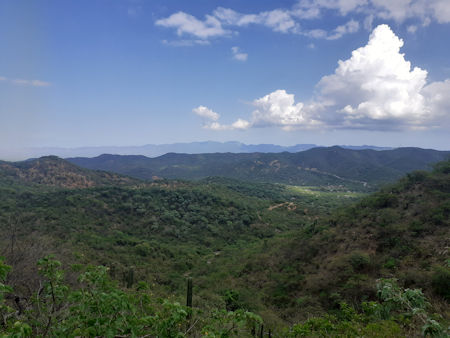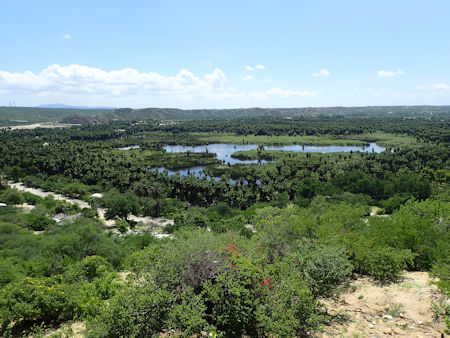 |  |
A visit to Rancho Ecológico Sol de Mayo in the Sierra de La Laguna, B.C.S., Mexico
By Jay D. Gittens

As a kid growing up in London, the word ‘desert’ painted pictures in my mind of a barren, inhospitable and sun-scorched landscape that supported very little life. It was a place in old movies whose sweeping sand dunes and hostile environment claimed the lives of those failing to conclude the journey across the stricken land. But the Baja desert differs significantly from my ‘Sahara’ and other hot deserts of the world in that it is far more luscious thus harbours more life.
Much of the desert area of the Baja California peninsula forms part of the larger Sonoran Desert, a region exceeding 260,000 square kilometres and includes parts of Sonora, much of the Baja California peninsula and the islands of the Gulf of California in Mexico as well as parts of California and Arizona in the United States. It is divided into distinct biomes including coniferous, deciduous and tropical forests, dry desert, thorn scrub and oak woodlands.
The Sierra de La Laguna is a mountain range situated between La Paz and Los Cabos and is the southern-most mountain range on the Baja Peninsula. The area spans approximately 122 square kilometres with the highest elevation standing close to 2200 metres above sea level, the highest point in the state of Baja Sur. Almost 700 plant species have been described in these mountains, 79 of which are endemic. The richness and diversity of the fauna is also substantial. In fact, it’s widely considered as the most biodiverse region in all of the peninsula. Due to the biological and ecological importance of the Sierra de La Laguna, it was declared a UNESCO Global Biosphere Reserve in June 1994.
Several towns both sides of the peninsula serve as gateways into the mountain range. These include Todos Santos and Pescadero on the Pacific side and San Bartolo and Santiago on the gulf side. I head for Santiago since it’s a popular base offering very easy access to areas of outstanding natural beauty including my chosen spot at the waterfalls of Rancho Ecológico Sol de Mayo. Immediately following the first of the late summer rains, shrubs and trees whose branches had been devoid of leaves for perhaps eight months are once again lush and dormant seeds that had been patiently awaiting this life-giving precipitation burst into existence overnight.  Pink and yellow flowers pepper the landscape adding contrast to the sea of green that stretches away into the distance reaching even the highest peaks. The East Cape highway, formally the section of HW1 that passes through the cape region of B.C.S., is luscious on both sides. Despite the road being in excellent repair, keep a sharp eye out for cows and goats taking advantage of the succulent new grass shoots that line the road’s edges. As I progress along the highway, large clouds, residual from the recent rains, are being detained by the highest peaks. The mountains serve as nature’s water towers, extracting fresh water from the atmosphere and distributing it through an intricate labyrinth of streams and groundwater aquifers. In the Sierra de La Laguna, this process creates a vast network of oases that transform the landscape into something resembling a tropical rainforest but with its own unique assemblage of plants and animals.
Pink and yellow flowers pepper the landscape adding contrast to the sea of green that stretches away into the distance reaching even the highest peaks. The East Cape highway, formally the section of HW1 that passes through the cape region of B.C.S., is luscious on both sides. Despite the road being in excellent repair, keep a sharp eye out for cows and goats taking advantage of the succulent new grass shoots that line the road’s edges. As I progress along the highway, large clouds, residual from the recent rains, are being detained by the highest peaks. The mountains serve as nature’s water towers, extracting fresh water from the atmosphere and distributing it through an intricate labyrinth of streams and groundwater aquifers. In the Sierra de La Laguna, this process creates a vast network of oases that transform the landscape into something resembling a tropical rainforest but with its own unique assemblage of plants and animals.
From Santiago, ten kilometres of dirt road separate the town from my destination but will grant the safe passage of any regular 2-wheel drive car in normal, dry conditions. The Sierra de La Laguna can receive high levels of rainfall between August and November. The optimum months to visit are between November and April when rains are minimal and average air temperatures more comfortable. As I proceed slowly along the dirt road, I begin to grasp just how alive this desert really is. Lizards of various species scarper for the shrubbery to the side of the track as I approach. A Baja gopher snake, a species of nonvenomous snake endemic to Baja Sur, crosses the road just ahead of me before silently disappearing into a burrow in the bank. Flights of yellow butterflies are grouped together in patches on the dirt road, using their straw-like proboscises to drink from small puddles left by the passing rains. Black-tailed jackrabbits graze on shrubs close to the road’s edge and I spot a few unidentified rodents along the way. Despite being completely encompassed by wildlife, it feels very quiet and lonely here. Only the sounds produced by buzzing insects and birdlife nullify the silence.

After crossing over several cattle grids, I finally arrive to Rancho Ecológico Sol de Mayo. A small car park lays in front of the entrance to the trail where I am immediately welcomed by one of the workers who directs me to where I pay a small fee to enter the reserve. The trail is narrow and rocky but an easy hike. The smell of the humidity in the air is evident that a substantial body of water draws near which is further confirmed by the echoes of the main waterfall in the near-distance. Before long I come to a small clearing on the cliff edge and the waterfall emerges through the foliage. How irregular it is to see so much fresh water in the middle of a desert, a reminder of the diversity of nature that the peninsula embraces. Continuing along the path, I head down huge rock steps that have been shaped for convenience. A rope acts as a handrail to support your descent. The waterfall is stunning both in beauty and magnitude as large volumes of water tip over the cliff and cascade down the rock face forming an emerald-green pool. During the dry season the pool tends to be colourless.
I reduce down to my swim shorts to join the dozen or so people that arrived ahead of me. The coolness of the mountain water is welcoming against my sun-exposed skin and the sound of the waterfall is like soothing music. Being an ocean enthusiast, I included a mask and snorkel in my daypack. The sediment that lines the bottom of the pool resembles gold dust and I note several freshwater representatives of snappers, gobies and mullet. I swim closer to the cascading water and the bottom becomes too deep in which to stand as the sediment is forced away by the force of the falling water. Downstream is equally as stunning. Giant white-gray rocks direct the flow and the stream is lined with vibrant green plants, bushes and trees. Whatever pictures I had in my mind of a desert oasis are very close to what I am experiencing here.

Rancho Ecológico Sol de Mayo is really just the edge of the Sierra de La Laguna and is easily accessed with no real need for a guide. However, the mountain range is extensive. Some trails to the highest peaks require 3 to 4 days of hiking for the return journey and are poorly marked. For this reason, it is not advised to penetrate the sierra beyond your level of knowledge and ability. If you are interested in a more extensive and professionally guided tour within the Sierra de La Laguna, I will be arranging trips during the cooler months between November and April. You can contact me directly for more information.
Email: jaydgittens(at)gmail.com
Cell phone: +52.612.197.5824

I called Baja Bound and Rigo from customer service was the most helpful person I've ever spoken to!...

Use this Insurance Every Time I go to Baja .If you call them they have good service or you can get...

I wish every company was as easy to deal with as Baja Bound. I ended up staying in Baja longer than...